- Quick Read
- Deep Read ( 5 Min. )
In Today’s Issue
- Trump was convicted. A bigger verdict from US voters now awaits.
- Today’s news briefs
- Kharkiv hails Biden OK to strike Russia: ‘We’ve been waiting’
- Landmark Vermont law would make polluters pay for climate change
- From Cold War to 9/11 to ... beagles: Our senior scribe has made coverage a craft
- ‘Punjabi wave’ sweeps Canada with fusion of tradition, hip-hop
Monitor Daily Podcast
- Follow us:
- Apple Podcasts
- Spotify
- RSS Feed
- Download
TODAY’S INTRO
Peter Grier, and the stories behind the stories
 Mark Sappenfield
Mark Sappenfield
Perhaps the sanest advice Peter Grier received in his illustrious 45-year journey as a Monitor writer came, appropriately enough, from his wife. “This is crazy,” she said as he pulled an all-nighter to write our signature post-9/11 story. “You need to go to bed.”
Peter ignored the advice. Repeatedly. Whether it was all-nighters or unreasonably tight deadlines, Peter had a habit of making the very difficult look effortless. Today, with Peter on the cusp of retirement, Gail Russell Chaddock chats and laughs with him about one of the most portentous Monitor careers of recent decades – his own.
Share this article
Link copied.

Help fund Monitor journalism for $11/ month
Already a subscriber? Login

Monitor journalism changes lives because we open that too-small box that most people think they live in. We believe news can and should expand a sense of identity and possibility beyond narrow conventional expectations.
Our work isn't possible without your support.
Trump was convicted. A bigger verdict from US voters now awaits.
With November elections just five months away, Donald Trump’s conviction Thursday will test voters’ tolerance for the former president’s actions, as well as public confidence in American justice.

The “new normal’’ is settling in. Former President Donald Trump is now a convicted felon, pending appeal, after Thursday’s verdict in the New York trial centering on hush money payments. But there are no easy assumptions about the impact of Mr. Trump’s conviction, and both campaigns in the Trump-Biden rematch agree that the “real verdict” will come on Election Day, Nov. 5.
“All of us who knew that there was no way [Mr. Trump] could be elected after the ‘Access Hollywood’ video in 2016 are being a little cautious right now,” says Dan Schnur, communications director for Republican Sen. John McCain’s 2000 presidential campaign and now an independent.
That video, in which Mr. Trump boasted crudely about grabbing women, was leaked a month before the 2016 election. That November he lost the popular vote to Democrat Hillary Clinton but won in the Electoral College.
Today, in the RealClearPolitics average of major polls taken preconviction, Mr. Trump has a razor-thin lead over President Joe Biden. All eyes are now on postconviction surveys. An overnight poll by YouGov of more than 2,600 U.S. voters found that half of Republicans are even more likely to vote for Mr. Trump since the verdict.
Trump was convicted. A bigger verdict from US voters now awaits.

The “new normal” is settling in. Former President Donald Trump is now a convicted felon, pending appeal, after Thursday’s verdict in the New York trial centering on hush money payments to a porn star. Supporters are rallying to his side, donating money, and raising loud objections to what many of them see as a rigged legal system.
Meanwhile, Democrats who have long dreamed of seeing Mr. Trump behind bars – still improbable but not impossible – are cheering. Others, including President Joe Biden, are playing things more cautiously. Candidates in both parties running for other offices downballot are also having to strategize around the new reality of a ticket-topper convicted of 34 felonies.
But in the Trump-Biden presidential rematch that’s shaping up, there’s at least one point both campaigns agree on: that the “real verdict” will come on Election Day, Nov. 5. And with a little over five months to go, these early days posttrial are a time for wariness, not easy assumptions about the impact of Mr. Trump’s conviction, political analysts say.
“All of us who knew that there was no way [Mr. Trump] could be elected after the ‘Access Hollywood’ video in 2016 are being a little cautious right now,” says Dan Schnur, communications director for Republican Sen. John McCain’s 2000 presidential campaign and now an independent.
That video, in which Mr. Trump boasted crudely about grabbing women, was leaked a month before the 2016 election, and appeared to doom the Republican nominee’s chances of becoming president. Indeed, that November he lost the popular vote to Democrat Hillary Clinton, but won in the Electoral College.

Polls show Trump’s base remains loyal
Today, in the RealClearPolitics average of major polls taken preconviction, Mr. Trump has a razor-thin lead over Mr. Biden. All eyes are now on postconviction surveys. An overnight poll by YouGov of more than 2,600 U.S. voters found that half of Republicans are even more likely to vote for Mr. Trump since the verdict, but the longer-term impact of the verdict on voter behavior remains to be seen.
Plenty of polls taken pre-verdict showed a small slice of the GOP electorate unwilling to vote for Mr. Trump if he was convicted, or at least reconsidering support for him. But such polls can’t simulate the real-world conditions of news coverage and the responses of public figures, including Mr. Trump, experts on polling say.
On Friday, the former president spoke for over a half hour at Trump Tower in New York, calling the trial “rigged” and the judge who presided the “devil.” Mr. Trump also said he would appeal the conviction, which included a finding of guilt on 34 counts of falsifying business records over hush money payments to porn actor Stormy Daniels, with whom he allegedly had a sexual encounter.
For more than six weeks, the trial required Mr. Trump to be present in the courtroom. Now that it’s over, he has more time to campaign – albeit with uncertainty about what a July 11 sentencing will bring. This means more opportunity to refresh public impressions and make his pitch for another term.
For Democrats, the job now is to talk about the hush money case in the context of the other three criminal cases pending against Mr. Trump, says Karen Finney, a Democratic strategist. Those cases center on alleged mishandling of classified documents, his alleged effort to overturn the 2020 election, and a racketeering case in Georgia over his alleged attempt to overturn that state’s 2020 election result.
“Is this someone you really want to trust your future to?” she suggests as a campaign message.

Democrats to focus on top-of-mind issues
More broadly, Ms. Finney and others suggest, Mr. Biden and the Democrats also need to focus on the issues that are top of mind for many voters, such as the economy.
Mr. Schnur, the former GOP strategist, notes that Mr. Biden has been struggling with elements of his base for months over issues such as the war in Gaza and climate change. The risk to Mr. Biden is that they don’t vote or vote third-party.
“Many of those disaffected progressives say that, because Biden hasn’t been as aggressive on their issues as they want, there’s no real difference between the two candidates,” says Mr. Schnur, a professor at the University of Southern California’s Annenberg School of Communications. “The question is whether the Biden campaign can use this [verdict] to convince the Democratic base that there is a real difference between him and Trump.”
So far, both Mr. Biden and his reelection campaign have been reactive. Right after the verdict, the White House counsel’s office said simply, “We respect the rule of law, and have no additional comment.” The Biden campaign fundraised off the verdict, sending emails stating that the only way to keep Mr. Trump out of office is “at the ballot box.”
On Friday, Mr. Biden himself commented on the Trump verdict for the first time, calling Mr. Trump’s morning remarks “unhinged.”
“Downballot” impact and fundraising
But another event Friday brought home the challenge the president faces in holding the Democratic coalition together: the departure of Sen. Joe Manchin of West Virginia from the party ranks. Senator Manchin announced that he has re-registered as an independent, raising speculation he could run for governor or even reelection to the Senate under that banner.
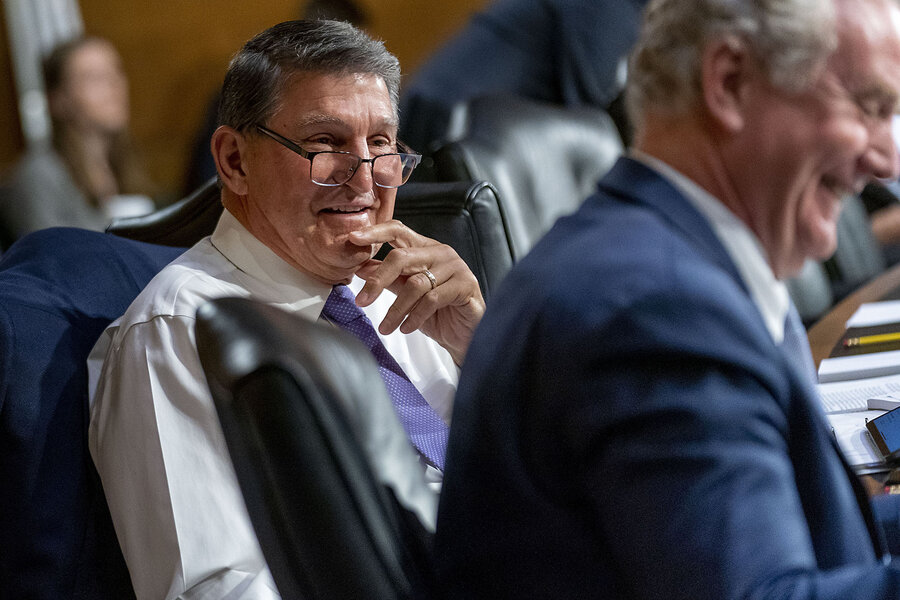
For some Republican candidates downballot, the Trump conviction may prove a double-edged sword. In solid-blue Maryland, popular former moderate GOP Gov. Larry Hogan is running a competitive race for the Senate, and needs to attract both pro-Trump Republicans and anti-Trump Democrats in November.
As Thursday’s verdict was about to be read, Mr. Hogan – a Trump critic – urged Americans to “respect the verdict and the legal process.” Not long after, senior Trump campaign adviser Chris LaCivita fired back: “You just ended your campaign.”
For other Republicans, the Trump conviction has produced a reported windfall in fundraising – as it did for Mr. Trump himself. On Friday morning, the Trump campaign said it had raised $38.4 million following the verdict, much of it reportedly from first-time donors. Traffic to the fundraising site was so strong that it temporarily crashed, according to the campaign.
In Arizona, Pinal County Sheriff Mark Lamb, who is running against former TV anchor and Trump loyalist Kari Lake in the GOP primary for Senate, said his fundraising page crashed, too.
“It’s not just Trump. People like myself are benefiting” from the verdict, Sheriff Lamb said Thursday. “I just did a fundraiser tonight and these folks were upset.”
Staff writer Story Hinckley contributed to this article.

Today’s news briefs
• Manchin leaves Democrats: Sen. Joe Manchin of West Virginia says he has registered as an independent, raising questions about his future political plans.
• New Caledonia under control: The French interior minister says French authorities in New Caledonia have regained full control of the Pacific territory’s capital after two weeks of unrest.
• Airstrikes on Houthis: Joint British-U.S. airstrikes targeting Yemen’s Houthi rebels kill at least 16 people and wound 42 others, according to the rebels.
• Free tax filing: The IRS will make permanent the free electronic tax return filing system that it experimented with this year.
• Spelling bee winner: Bruhat Soma, a 12-year-old from Tampa, Florida, is the champion of the 2024 Scripps National Spelling Bee after winning the competition’s second spell-off to date. His championship word was “abseil.”

Kharkiv hails Biden OK to strike Russia: ‘We’ve been waiting’
Throughout the war in Ukraine, a recurring theme has been Kyiv’s gratitude for U.S. military aid tinged with impatience over its timeliness. President Joe Biden’s decision to allow use of U.S. weapons against some targets in Russia fits the pattern.
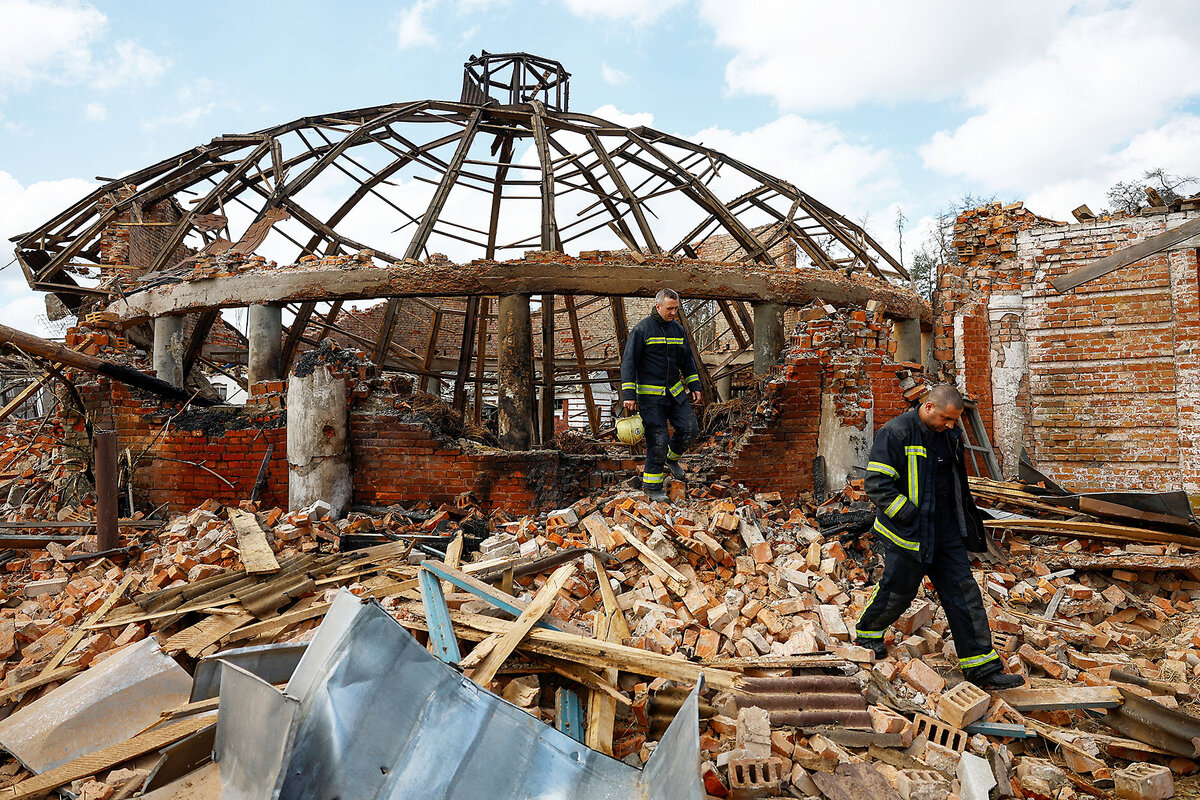
- Quick Read
- Deep Read ( 5 Min. )
The news that President Joe Biden will authorize Ukraine to use U.S.-provided weapons to strike inside Russian territory along the Kharkiv region’s front lines was received here Friday with relief and appreciation – but also regret that the decision hadn’t come earlier.
Just the night before, at least six civilians were killed when glide bombs launched from Russian airspace struck in Kharkiv, the country’s second-largest city. Earlier this month, two guided bombs struck a building supply superstore crowded with civilians, killing at least 16.
Still, the predominant sentiment here is a confidence that Ukraine will benefit from Mr. Biden’s decision: It will allow them to target more effectively the Russian forces just across the international border, and perhaps even allow Ukraine to stymie Russia’s current offensive into the Kharkiv region.
“We have to be able to strike the air bases inside Russia where the aircraft that launch these bombs that are hitting in Kharkiv take off,” says Col. Yurii Povkh, spokesperson for the Kharkiv Operational Tactical Group.
“We’ve been waiting for this permission” from Mr. Biden, says Gregory Shcherban, a volunteer with a local nongovernmental organization that helps international reporters. “Of course, we might have avoided some of these tragedies if this had come earlier.”
Kharkiv hails Biden OK to strike Russia: ‘We’ve been waiting’
The news that President Joe Biden will authorize Ukraine to use U.S.-provided weapons to strike inside Russian territory along the Kharkiv region’s front lines was received here Friday with relief and appreciation – but also regret.
Just the night before, Russian glide bombs launched from aircraft in Russian airspace struck in Kharkiv, Ukraine’s second largest city, located just 19 miles from the Russian border. At least six civilians were killed when an apartment building was hit, although a search for the missing continued Friday.
Earlier this month, two guided bombs struck a building supply superstore crowded with civilians – including shoppers picking up materials to repair the damage inflicted as Russia has picked up the pace of its attacks on the Kharkiv region. At least 16 were killed in that attack, and dozens injured.
If Mr. Biden’s decision had come earlier, some here say, maybe some of these tragedies could have been avoided.
Still, the predominant sentiment among military and other sources here is a confidence that Ukraine will be able to reap the benefits of this decision by targeting more effectively the Russian forces and installations concentrated just across the international border.
And that in turn should allow Ukrainian forces to stymie the surprise offensive that Russia launched into the Kharkiv region this month.

“We have to be able to strike the air bases inside Russia where the aircraft that launch these bombs that are hitting in Kharkiv take off. We have to be able to target the bases where their troops that are carrying out their offensive gather and prepare to attack our villages,” says Col. Yurii Povkh, spokesperson for the Kharkiv Operational Tactical Group.
“It’s much more efficient and effective to fight the reasons we’re taking these hits,” he adds, “than to simply fight the consequences,” such as the Russian offensive, which left border villages scorched and hundreds of civilians frantically evacuating to safer ground.
Scorched earth
“We’ve been waiting for this permission” from Mr. Biden, says Gregory Shcherban, a volunteer with Kharkiv Media Hub, a local nongovernmental organization that helps international reporters get the Kharkiv story. “Of course we might have avoided some of these tragedies if this had come earlier.”
Mr. Shcherban’s work took him last week to Vovchansk, one of the border villages where Russian forces moved in with a scorched-earth strategy, burning, smashing, and targeting everything in their path. He ended up using his red van to evacuate as many residents as he could – including one terrified farmer’s bleating goats.
“These people fear this will be their last trip from their homes,” he says. “We have to be able to strike the military bases inside Russia where these operations are being prepared and organized.”

President Biden has been reluctant to allow Ukraine to use U.S.-supplied weapons to target military facilities inside Russia over concerns it could lead to a direct conflict between two nuclear superpowers. Indeed, Russian President Vladimir Putin responded to speculation earlier this week that Mr. Biden’s decision was coming by again warning that any such green light would risk nuclear war.
But pressure has mounted over recent months – from some members of Congress and some NATO countries – for the United States to relax the ban.
In the end, two key factors finally pushed Mr. Biden across the line, some diplomatic analysts believe.
One was the alarming assessment of conditions around Kharkiv that Secretary of State Antony Blinken delivered to the president after visiting Kyiv earlier this month. According to officials, Mr. Blinken reported that not just the border region but the city of Kharkiv could fall if Russia’s advance was not effectively countered.
A second concern, some analysts say, was the prospect of dark news about the war in Ukraine landing just as Mr. Biden is to host NATO partners in Washington for the Alliance’s 75th anniversary summit in July.
The limited OK to use the U.S. weapons to strike inside Russia comes even as Ukraine begins to reap the benefits of the $60 billion military assistance package Congress approved last month.

Along the 900-mile-long front lines in eastern and northern Ukraine, military units that just weeks ago complained of a debilitating lack of artillery shells and other munitions are reporting an ability to once again match their Russian adversaries.
Defensive posture
Pentagon officials say privately that a ramping up of weapons deliveries will take time and will continue well into the summer. And most Ukrainian military analysts caution that the fresh arms deliveries should not prompt sky-high expectations.
“We have to be realistic, at least until the end of summer we will have to be in a defensive position,” says Oleksandr Kovalenko, military and political director of the Informational Resistance Group, a Kyiv-based defense think tank. “We lost too many opportunities and suffered high losses during the months when we were receiving no arms supplies from our partners.”
Mr. Kovalenko says he believes Russia’s aim in Kharkiv is to occupy neither the region, nor a city that before the war counted over 1.4 million residents. “Their objectives are more political,” he says, aimed at disheartening the public, destroying the economy, and thinning out the population.
If that’s the case, President Biden’s greenlighting of strikes inside Russia could be one antidote, Colonel Povkh says.
“People in Kharkiv ask me all the time, ‘When are you going to push these terrorists away from the border and stop these attacks on our homes?’” he says. “I’m sure this [decision] will lift our citizens’ morale and raise their sense of security about living here.”
Oleksandr Naselenko assisted in reporting this story.

Landmark Vermont law would make polluters pay for climate change
Increasingly costly incidents of extreme weather are taking a toll on state budgets. Flood-ravaged Vermont is trying to make carbon emitters pay, with a first-of-its-kind law that’s creative but legally controversial.
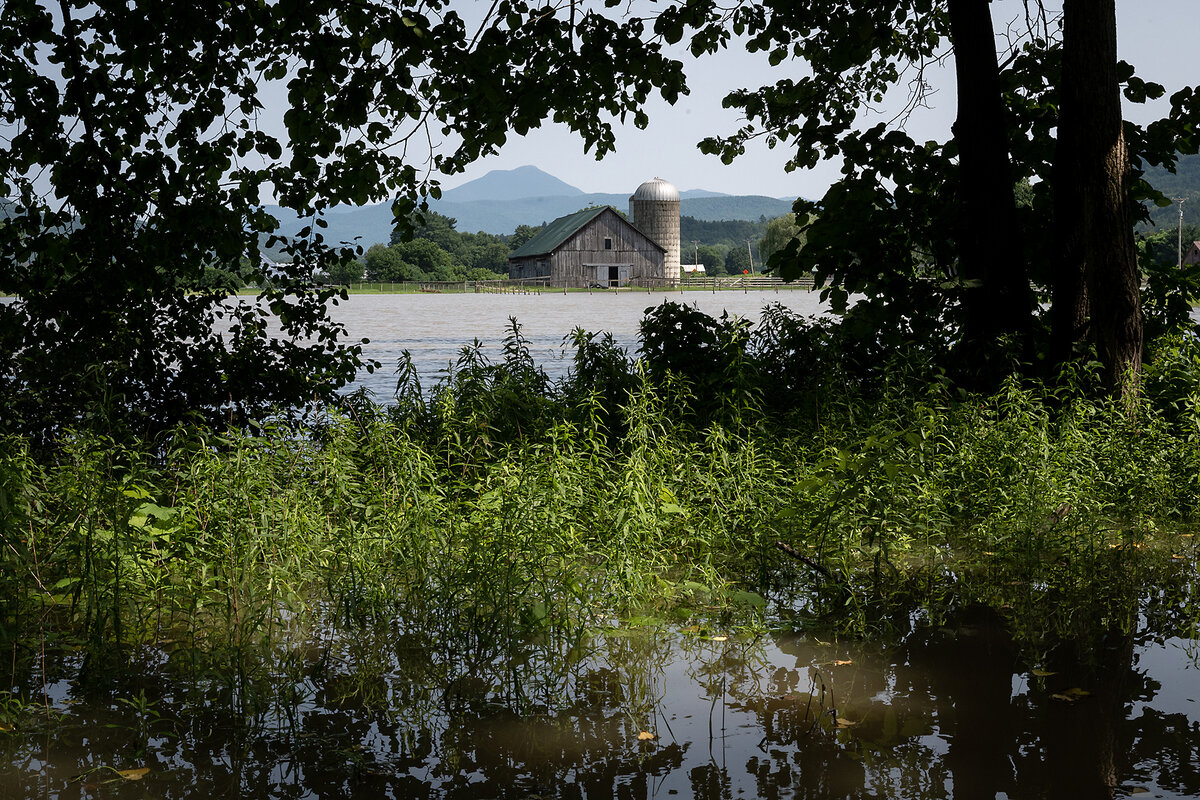
- Quick Read
- Deep Read ( 5 Min. )
-
Stephanie Hanes Staff writer
Vermont on Thursday became the first U.S. state to demand that oil and gas companies pay for the costly impacts of climate change – a move that many experts say could pave the way for similar legislation across the country.
Taking many climate advocates by surprise, Republican Gov. Phil Scott allowed passage of the new, bipartisan Climate Superfund legislation. It lets Vermont’s department of natural resources recover costs from those fossil fuel companies responsible for more than 1 billion metric tons of greenhouse gas emissions in the state. The money would go toward climate change adaptation or resilience infrastructure.
Although most experts – including lawmakers themselves – expect a slew of legal challenges to the legislation, many see it as a groundbreaking effort to use a “polluters pay” model to manage skyrocketing expenses hitting state and local governments because of climate change.
“This is a creative attempt to place the costs of climate damage on the companies whose products produced it,” says Martin Lockman, law fellow at Columbia University’s Sabin Center for Climate Change Law.
Landmark Vermont law would make polluters pay for climate change
Vermont on Thursday became the first state in the United States to demand that oil and gas companies pay for the costly impacts of climate change – a move that many experts say could pave the way for similar legislation across the country.
Taking many climate advocates by surprise, Republican Gov. Phil Scott allowed passage of the new, bipartisan Climate Superfund legislation, which lets Vermont’s department of natural resources recover costs from those fossil fuel companies responsible for more than 1 billion metric tons of greenhouse gas emissions in the state. The money would go toward climate change adaptation or resilience infrastructure.
Although most experts – including lawmakers themselves – expect a slew of legal challenges to the legislation, many see it as a groundbreaking effort to use a “polluters pay” model to manage skyrocketing expenses hitting state and local governments because of climate change. From revamping stormwater systems to deal with salt water incursion, to repairing bridges and roadways washed out from unusually heavy rain storms, to building new seawalls to protect from stronger hurricanes, municipalities across the country are looking at massive financial outlays.
“States need this money,” says Martin Lockman, law fellow at Columbia University’s Sabin Center for Climate Change Law in New York. “States are facing increasing risk of natural disasters. They’re facing chronic pressures from their changing climate that are really going to stress their infrastructure, their economies. ... This is a creative attempt to place the costs of climate damage on the companies whose products produced it.”

First-of-its-kind law likely headed to court
The law will likely be challenged in court – notably by the fossil fuel industry.
The American Petroleum Institute, a lobbying group for the industry, has opposed the new law, saying that it is unconstitutional for a slew of reasons, as well as poor policy.
“This bill is nothing more than an unnecessary new fee on American energy that would only stall the innovative progress underway to accelerate low-carbon solutions while delivering the energy communities need,” says Scott Lauermann, API spokesperson.
The unique legislation expands the “polluter pays” principle, a central tenet of U.S. environmental law that essentially says polluters are responsible for cleaning up the messes they make. Congress passed the Comprehensive Environmental Response, Compensation and Liability Act in 1980 – a law commonly known as “Superfund” – to help force companies cover the cost of hazardous waste removal and mitigation.
The “climate superfund” concept expands on this, with the idea that carbon dioxide, a primary greenhouse gas responsible for human-caused climate change, is the pollutant.
This stance is bolstered by a growing field of climate modeling that traces the line from carbon emitter to extreme weather events. This “climate attribution science” can say that a particular event was a certain percentage more likely because of a warming climate. The Vermont legislation uses the Carbon Majors database to populate sophisticated models to determine the damages caused by greenhouse gas emissions in the state.
“We are at a point where there is a very sound, peer-reviewed methodology for connecting the dots between how much fossil fuel companies emitted into the atmosphere and what the economic costs of those emissions are on the ground here in Vermont,” says Elena Mihaly, vice president of Conservation and Law Foundation Vermont.

How a natural disaster led to legislation
The Green Mountain State experienced catastrophic flash floods and flooded rivers last summer, which dealt more than $2.2 billion in damages, according to the National Oceanic and Atmospheric Administration. Montpelier, Vermont, received a record-breaking 5.28 inches of rain, flooding the capital and damaging thousands of homes and businesses.
Some areas reported more than 8 inches of rain within 24 hours, causing extensive damage to communities as well as road and bridge infrastructure, and prompting hundreds of evacuations.
According to the National Climate Assessment, extreme precipitation events have increased in the Northeast by 60% since the 1950s.
For Vermonters, it’s been a wake-up call.
“For a long time, people figured Vermont was a climate haven. But after last summer’s flooding and then another flood in December, it really opened people’s eyes to the reality that climate damages are here and now,” says Ms. Mihaly.
Nearly two-thirds (64%) of Vermonters support the idea of requiring large oil and gas companies to pay a share of the cost for climate-resilient infrastructure projects, according to a poll by Data For Progress. Even with federal funding for disaster relief, the state and local municipalities are still paying tens of millions for repairs for last summer’s damage.
Justin Mankin, professor of climate variability at Dartmouth College, says last year’s floods were the “immediate catalyst” for climate action in the state, but just another example in a growing list of extreme weather events exacerbated by warming.
“This isn’t a problem for 2100,” says Mr. Mankin, noting that 2023 was the hottest year on record. “The impacts of warming are here now and they’re impacting people in tangible ways that can be documented. That’s a crucial change for social palatability for these types of legislation.”

California, Massachusetts, Maryland, and New York are considering similar legislation to establish climate resiliency funds.
Under the Vermont law, the state treasurer would compile a report of the companies responsible for more than 1 billion tons of greenhouse gas pollution in the state. Those companies would then make payments calculated based on each corporation’s emissions from 1995 to 2024.
Vermont’s Agency of Natural Resources would then allocate the funding for the Climate Superfund Cost Recovery Program Fund to enhance infrastructure and weatherproof public buildings, and address the health impacts of climate change.
Vermont still will need to pay for many other resiliency and adaptation projects. But proponents of the Climate Superfund see it as an additional, crucial revenue stream to help local communities prep for the worst.
“Vermont and Vermonters are resilient and will come together,” says Ben Walsh of the Vermont Public Interest Research Group. “But we’re just asking too much of them if we’re asking them to shoulder that burden by themselves.”

Podcast
From Cold War to 9/11 to ... beagles: Our senior scribe has made coverage a craft
Last week on our podcast, veteran Washington writer Peter Grier talked about trust and U.S. elections. In this week’s episode, on the cusp of retirement, he looks back at some moments from a remarkable career.

Episodes of the Monitor’s “Why We Wrote This” podcast typically focus on one story. You can look back to last week to hear how senior staff writer Peter Grier approached restoring trust in U.S. elections.
This episode is a little different. It’s about how he managed a storied 45-year Monitor career.
“Write like Peter Grier.” That’s the advice I was given as a new Monitor hire, midcareer with no experience in journalism. The first lessons were obvious: Write shorter sentences. Then write longer ones, with enough energy to get to the period. Be simple. Be clear. Above all, be fresh. If you’ve written a dull sentence, get rid of it.
But that stylebook alone doesn’t make you a writer that readers come back to, year after year. That takes experience. It also takes heart. That’s why our audio team has been calling this episode “Becoming Peter Grier.” We invite you to listen. – Gail Chaddock and Jingnan Peng
Find story links and a full transcript here.
A Writer’s Retrospective

‘Punjabi wave’ sweeps Canada with fusion of tradition, hip-hop
Music can make a community feel heard – not just literally, but figuratively, too. The rise of a “Punjabi wave” in international music is helping the Indian diaspora in Canada feel recognized in a new way.

- Quick Read
- Deep Read ( 5 Min. )
From Coachella stages to Spotify playlists, a “Punjabi wave” is surging across the international music scene. Its creators, mostly Sikhs from northwestern India, mix traditional music with the hip-hop, rap, and pop beats of North America. And Canada-based musicians are leading the way.
The genre is buoyed by the country’s swelling Indian population, as well as a growing willingness among white audiences to listen to foreign-language music, says MacEwan University professor Sara Grewal.
Canada has the largest percentage of Sikhs outside Punjab, and many Punjabi singers came to the country as international students. Some see the Punjabi wave as a vehicle for keeping immigrants and second-generation Indians connected to their homeland.
Kavita Saini, who was born to Indian parents in small-town British Columbia, says Punjabi music wasn’t something she used to hear on mainstream airwaves. But recently, she and more than 50,000 others flocked to Vancouver to see Punjabi singer Diljit Dosanjh perform live.
“Now the music has blown up and it’s like, we’re getting known,” says Ms. Saini. It’s her 9-year-old son’s first concert, the largest Punjabi show ever played outside India. “There is so much talent, so I’m just proud of us.”
‘Punjabi wave’ sweeps Canada with fusion of tradition, hip-hop
“Get ready to experience the biggest Punjabi artist on the planet of all time,” the voice booms across the darkened stadium.
The sold-out crowd, over 50,000 in all, roars as the lights go up and Diljit Dosanjh takes the Vancouver stage. He’s dressed in all black – from his turban, to tunic, to tinted sunglasses – except for a pair of red Nike high-tops.
And if the audacious welcome message – calling the audience the “special chosen ones” about to “witness history” – seems over the top, Mr. Dosanjh does indeed make history. The first leg of his North American tour that runs across Canada and the U.S. into the summer is touted as the largest Punjabi show ever played outside India.
It’s a dazzling expression of the “Punjabi wave” surging across the international music scene. Its creators, mostly Sikhs from northwestern India, mix traditional music with the hip-hop, rap, and pop beats of North America. And Canada-based musicians are leading the way. It’s a nod to the remarkable Punjabi immigration story – with all its complexities – across this country.

“This is the Punjabi wave. Nobody ever thought somebody would come and sell out BC [Place] Stadium,” says Robyn Sandhu, who came to Canada from India as an international student in 2017 and is now a hip-hop singer penning Punjabi lyrics from Surrey, British Columbia. “They’d say, ‘What are you talking about?’ It’s just crazy.”
The Canadian dream
Punjabi hip-hop, rap, and pop is definitely having a moment. In April, Canada-based Punjabi rapper AP Dhillon performed at the Coachella music festival, after Mr. Dosanjh became the first Punjabi artist to take the California stage last year. In March, Punjabi rapper Karan Aujla, based in British Columbia, took home the 2024 Fan Choice Award at Canada’s annual JUNO Awards. According to Spotify, consumption of music from India has shot up worldwide by 2,000% in the past five years.
Kavita Saini, who was born to Indian parents in small-town British Columbia, says Punjabi music was once something she heard only at weddings or inside her home, not on mainstream airwaves.
“When I was growing up, I was a minority. Now the music has blown up and it’s like, we’re getting known,” says Ms. Saini, at the Dosanjh show with her 9-year-old son at his first concert; an aunt celebrating her 76th birthday; and her mother, who keeps warning her to be wary of two journalists who approach her in case it’s a scam. “Our culture and music is getting known, and our actors and actresses. There is so much talent, so I’m just proud of us.”

The swelling Indian population in Canada buoys the genre. Canada has the largest percentage of Sikhs outside Punjab. The Indian migrant population here has grown by over a third between 2016 and 2021. Of the nearly one million international students who arrived in Canada last year, 40% hailed from India.
Many Punjabi singers – and their producers, managers, and lyricists – came as international students themselves and generated this newest wave, though Sara Grewal, a professor at MacEwan University in Alberta who is co-writing a book on Canadian Sikh hip-hop artists, says the fusion is not new. It’s simply more mainstream now that white audiences are more willing to listen to music in foreign languages.
The international student migration story is central to many Sikh singers. “For some artists, it shows up in their lyrics as the ‘Canadian dream,’ the international student with one suitcase … who is now a big star,” she says. Others rap about the discrimination international students face both by Canadians and the Punjabi community itself.
On the contrary, fraught politics between India and Canada over the assassination of a Sikh separatist leader on Canadian soil last year have hardly registered in the music.

Homeland connections
The Punjabi diaspora is centered in Brampton and Surrey, in greater Toronto and Vancouver respectively. The most recent wave of fusion music is often traced to the late Sidhu Moose Wala, an artist who had moved to Brampton as an international student and was gunned down while in India where he’d launched into politics. But the music’s hub has shifted westward in recent years.
The Punjabi community of Surrey, where nearly 30% of residents identify as Sikh, is concentrated around 128 Street. Mr. Sandhu, who goes about his days penning poems on his iPhone, spent a recent Sunday drinking mango lassis at the town’s Little India Plaza with friends, all newly arrived international students. The night before, he’d been recording a song he dubbed “128,” an ode to a city he says he loves. But in the Punjabi wave, he sees a vehicle for keeping immigrants and second-generation Indians connected to their homeland.
“A huge part of the diaspora was born here and was sort of disconnected from their culture. But once they found Punjabi music, they found a lens onto the culture,” he says. “We listen to the same music as you do. We listen to Michael Jackson. We listen to Tupac. … We’re in North America speaking English and listening to English beats and we’re rapping Punjabi over it.”

“We are so excited,” says Ikvir Chahal, who is waiting outside for the Diljit Dosanjh concert to begin. Born in Vancouver, she is here with her younger sister and friend. The girls, all students at the University of British Columbia, show off their iPhones with wallpaper images of Mr. Dosanjh. Ms. Chahal’s father, Kuldip Singh Chahal, approaches the group with his eyes lit, talking about how his village back in India is next door to Mr. Dosanjh’s.
He doesn’t have to convince his daughters that this is worth knowing.
Ms. Chahal says she loves North American rap and hip-hop. “But I love music in my language. It has a different touch. A magic to it,” she says. “We love our Punjabi music.”
Other headline stories we’re watching
(Get live updates throughout the day.)The Monitor's View
A jury’s calm reasoning
- Quick Read
- Deep Read ( 2 Min. )
-
By the Monitor's Editorial Board
Thursday’s guilty verdict against Donald Trump has raised concerns about a possible effect on democracy in the future: Will prosecutors aligned with one party now feel emboldened to indict elected leaders of another party? The performance of the jury in the Trump trial offers a calming insight.
A few hours into their deliberations, the jurors returned with three requests. They wanted headphones to better review recorded testimony. They asked for a rereading of transcripts of witness accounts. Their concern for factual accuracy was matched by a third, more revealing request.
New York state law does not allow judges to hand out the instructions they give juries for rendering verdicts. That guidance must be read from the bench. Judge Juan Merchan’s ran 55 pages. The jurors returned to hear again a specific passage. It read, “In deciding whether to draw an inference, you must look at and consider all the facts in the light of reason, common sense, and experience.”
In the first criminal trial of a former American president, 12 jurors followed the facts and the law. In times of high political passion, they showed temperance of reason in the pursuit of truth. Democracy relies on the wisdom and impartiality of such everyday folks.
A jury’s calm reasoning
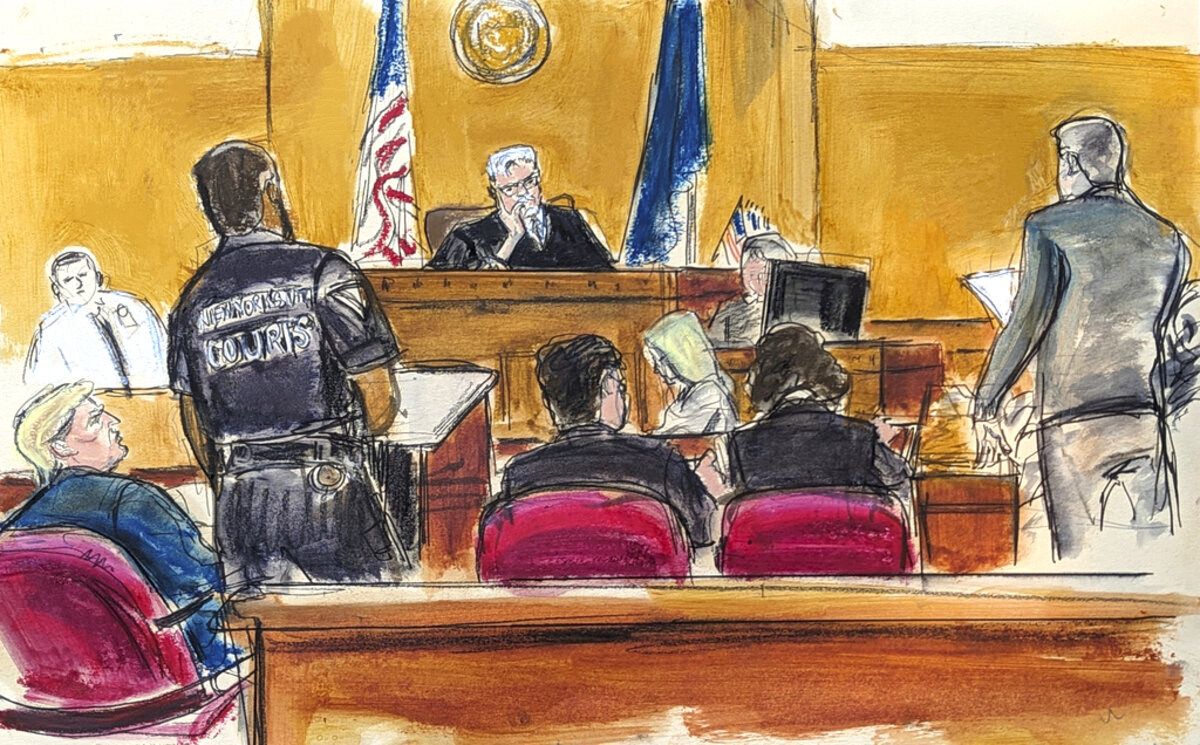
Thursday’s guilty verdict against Donald Trump on 34 felony counts has raised concerns about a possible effect on democracy in the future: Will prosecutors aligned with one party now feel emboldened to indict elected leaders of another party? The performance of the jury in the Trump trial offers a calming insight.
Mr. Trump, who plans to appeal the verdict, and his supporters had claimed that he could not obtain a fair trial in New York because it is overwhelmingly liberal. The public actually knows little about the individual jurors. They were vetted by both sides during jury selection and asked whether they could weigh evidence dispassionately, particularly in a case involving such a well-known figure.
A few hours into their deliberations, the jurors returned with three requests. They wanted headphones to better review recorded testimony. They asked for a rereading of transcripts of witness accounts of pivotal events. Their concern for factual accuracy was matched by a third, more revealing request.
New York state law does not allow judges to hand out the instructions they give juries for rendering verdicts. That guidance must be read from the bench. Judge Juan Merchan’s ran 55 pages. The jurors returned to hear again a specific passage. It read, “In deciding whether to draw an inference, you must look at and consider all the facts in the light of reason, common sense, and experience.”
Reason, notes Andrew Walker, an ethics professor at the Southern Baptist Theological Seminary, ties self-government to conscience and reconciliation. It rests on evidence, and favors listening and empathy over emotion and instinct. “To reason deeply,” he wrote in an essay for the Ethics and Public Policy Center in Washington, “must mean there is an honest airing of differences and an honest willingness to hear the other’s side.”
An innate capacity for ordinary citizens to subordinate their own views to reason and place justice ahead of personal preference may be why a right to trial by jury was one of the few points that drew universal agreement in America’s founding constitutional debates. Elbridge Gerry of Massachusetts summarized that consensus in observing that “the jury is adapted to the investigation of truth beyond any other system the world can produce.”
Fifty-three “free” or “partly free” countries have indicted past or present heads of state since 2000, according to a survey last year by Foreign Policy magazine. One common lesson is that countries with strong democratic institutions often emerge even stronger through those prosecutions. The exercise of equality before the law deepens civic trust.
In the first criminal trial of a former American president, 12 fairly selected jurors followed the facts and the law. In times of high political passion, they showed temperance of reason in the pursuit of truth. Democracy relies on the wisdom and impartiality of such everyday folks.

A Christian Science Perspective
Each weekday, the Monitor includes one clearly labeled religious article offering spiritual insight on contemporary issues, including the news. The publication – in its various forms – is produced for anyone who cares about the progress of the human endeavor around the world and seeks news reported with compassion, intelligence, and an essentially constructive lens. For many, that caring has religious roots. For many, it does not. The Monitor has always embraced both audiences. The Monitor is owned by a church – The First Church of Christ, Scientist, in Boston – whose founder was concerned with both the state of the world and the quality of available news.
Anyone can be a good neighbor
- Quick Read
- Read or Listen ( 2 Min. )
While a selfless deed done for another is always inspiring, a spiritual perspective shows us it doesn’t need to be out of the ordinary.
Anyone can be a good neighbor
A good Samaritan. It’s a phrase commonly used to describe someone who has gone out of their way to help a stranger. The care that’s expressed in this sort of situation can feel extraordinary.
However, when Jesus was sharing the parable of the good Samaritan, there was an expectation that anyone could and should care for others in the same way. His own uninhibited compassion was the perfect illustration of the rule he commended to all, God’s law of loving our neighbor as ourselves. Following a law certainly shouldn’t be exceptional.
Through Christian Science, many have felt impelled to help those around them even in situations when it felt difficult or uncomfortable to do so. Knowing that the Father-Mother of us all is the all-good God, and that we are expressions of this divine goodness, helps break through barriers to being a loving neighbor to those in need.
Here are several examples from the archives of The Christian Science Publishing Society that show how we can all be good Samaritans:
In “Loving our neighbor, or just ‘walking by’?” the author shows that when we think of everyone as our neighbor, we’re more ready and able to help those in need.
Helping our neighbor – yes, even our neighbors in jail – can look like sharing the truth of who they are as a child of God, as “Something we can all do to defuse violence” expresses.
In “Being a good Samaritan,” the author shares how seeing those around us as made in the likeness of God, good, can bring peace and comfort to heated situations.
“The power behind brotherly love” explores the great significance of divine Love-impelled kindness and generosity.

Viewfinder
Heading home
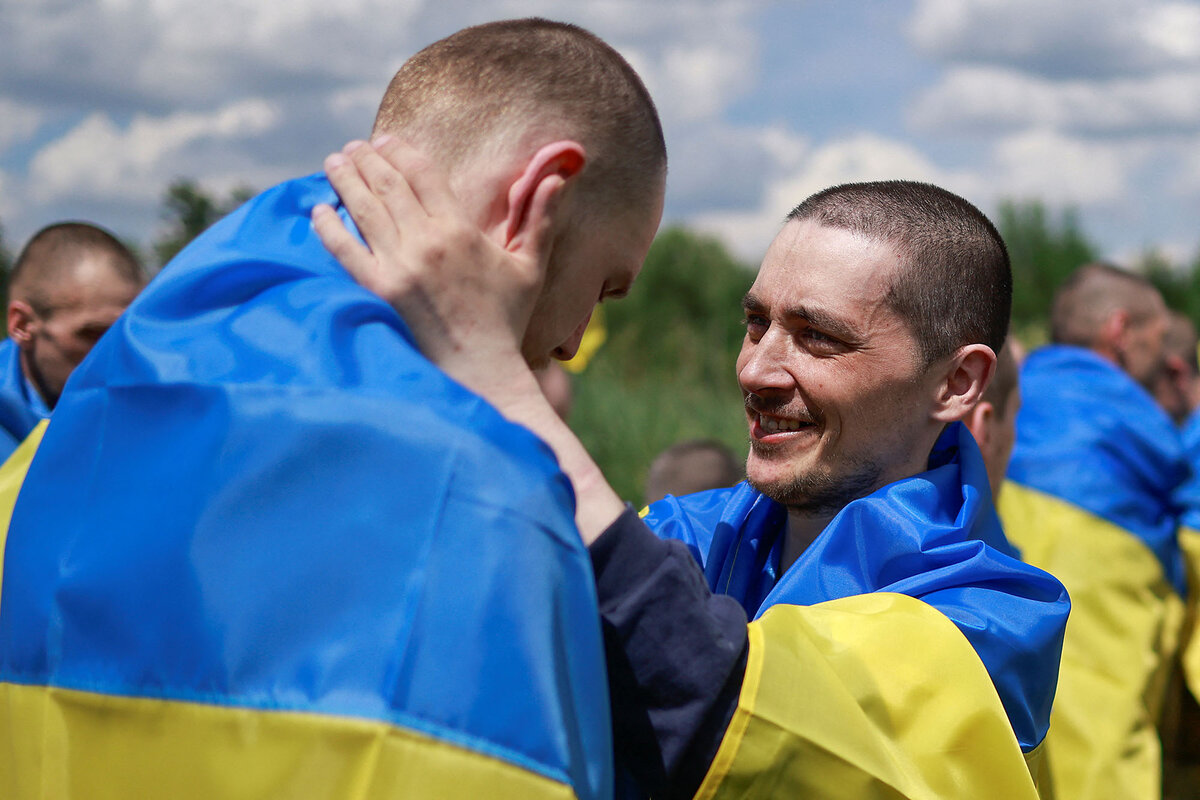
A look ahead
Thank you for joining us today. We’ll send you off into your weekend with a bonus read. Boeing has had its share of bad press recently over safety issues on its commercial airliners. It’s hoping that the launch of its new Starliner spacecraft tomorrow will provide a reset. You can read the story here.



